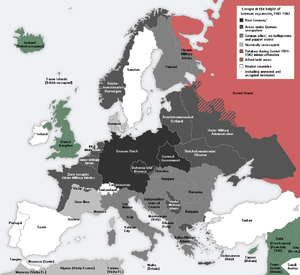German-occupied Europe

German-occupied Europe refers to the sovereign countries of Europe which were wholly or partly occupied and civil-occupied (including puppet governments) by the military forces and the government of Nazi Germany at various times between 1939 and 1945, during and shortly before World War II, generally administered by the Nazi regime, under the dictatorship of Adolf Hitler.[1] The German Wehrmacht occupied European territory:
- as far east as the town of Mozdok in the North Caucasus in the Soviet Union (1942–1943)
- as far north as the settlement of Barentsburg in Svalbard in the Kingdom of Norway
- as far south as the island of Gavdos in the Kingdom of Greece
- as far west as the island of Ushant in the French Republic
Outside of Europe proper, German forces effectively controlled areas of North Africa in Egypt, Libya, and Tunisia at times between 1941 and 1943. German military scientists established the Schatzgräber weather station base (1941–1944) as far north as Alexandra Land in Franz Josef Land – arguably part of Asia. Manned German weather stations also operated in North America (Greenland: Holzauge, Bassgeiger, Edelweiss base – 1942–1944). Additionally, German Kriegsmarine vessels operated in all of the world's oceans throughout the war.
Background
Several German-occupied countries initially entered World War II as Allies of the United Kingdom[2] or the Soviet Union.[3] Some were forced to surrender before the outbreak of the war such as Czechoslovakia;[4] others like Poland (invaded on 1 September 1939)[1] were conquered in battle and then occupied. In some cases, the legitimate governments went into exile, in other cases the governments-in-exile were formed by their citizens in other Allied countries.[5] Some countries occupied by Nazi Germany were officially neutral. Others were former members of the Axis powers that were subsequently occupied by German forces.[6][7]
Occupied countries
The countries occupied included all, or most of the following:
Governments in exile
Allied governments in exile
Axis governments in exile
| Government in exile | Capital in exile | Timeline of exile | Occupier(s) |
|---|---|---|---|
| September 16, 1944 – May 10, 1945 | |||
| 1944 – April 22, 1945 | |||
| March 28/29, 1945 – May 7, 1945 | |||
| 1944–1945 | |||
| Summer of 1944 – May 8, 1945 | |||
| April 4, 1945 – 8 May 1945 |
Neutral governments in exile
| Government in exile | Capital in exile | Timeline of exile | Occupier(s) |
|---|---|---|---|
(1923–1938)
|
1919 – present |
| |
(1944 – August 20, 1991) |
June 17, 1940 – August 20, 1991 | ||
(1920–1939)
|
1920 – August 22, 1992 |
|
See also
- Areas annexed by Germany
- Underground media in German-occupied Europe
- Drang nach Osten ("The Drive Eastward")
- Greater Germanic Reich
- Lebensraum ("Living Space")
- Neuordnung ("New Order")
- Pan-Germanism
- Russian-occupied territories
References
- ^ a b Encyclopædia Britannica, German occupied Europe. World War II. Retrieved 1 September 2015 from the Internet Archive.
- ^ Prazmowska, Anita (1995-03-23). Britain and Poland 1939–1943: The Betrayed Ally. Cambridge University Press. ISBN 9780521483858.
- ^ Moorhouse, Roger (2014-10-14). The Devils' Alliance: Hitler's Pact with Stalin, 1939–1941. Basic Books. ISBN 9780465054923.
- ^ Goldstein, Erik; Lukes, Igor (2012-10-12). The Munich Crisis, 1938: Prelude to World War II. Routledge. ISBN 9781136328329.
- ^ Conway, Martin; Gotovitch, José (2001-08-30). Europe in Exile: European Exile Communities in Britain 1940–45. Berghahn Books. ISBN 9781782389910.
- ^ Hanson, Victor Davis (2017-10-17). The Second World Wars: How the First Global Conflict Was Fought and Won. Basic Books. ISBN 9780465093199.
- ^ Cornelius, Deborah S. (2011). Hungary in World War II: Caught in the Cauldron. Fordham Univ Press. ISBN 9780823233434.
Bibliography
- Bank, Jan. Churches and Religion in the Second World War (Occupation in Europe) (2016)
- Gildea, Robert and Olivier Wieviorka. Surviving Hitler and Mussolini: Daily Life in Occupied Europe (2007).
- Klemann, Hein A.M. and Sergei Kudryashov, eds. Occupied Economies: An Economic History of Nazi-Occupied Europe, 1939–1945 (2011).
- Lagrou, Pieter. The Legacy of Nazi Occupation: Patriotic Memory and National Recovery in Western Europe, 1945–1965 (1999)
- Mazower, Mark (2008). Hitler's Empire: Nazi Rule in Occupied Europe. London: Allen Lane. ISBN 9780713996814.
- Scheck, Raffael; Fabien Théofilakis; and Julia S. Torrie, eds. German-occupied Europe in the Second World War (Routledge, 2019). 276 pp. online review
- Snyder, Timothy. Bloodlands: Europe Between Hitler and Stalin (2010), on Eastern Europe
- Toynbee, Arnold, ed. Survey of International Affairs, 1939–1946: Hitler's Europe (Oxford University Press. 1954) 730pp. online review; full text online free
Primary sources
- Carlyle Margaret, ed. Documents on International Affairs, 1939–1946. Volume II, Hitler's Europe (Oxford University Press. 1954) 362pp.)
